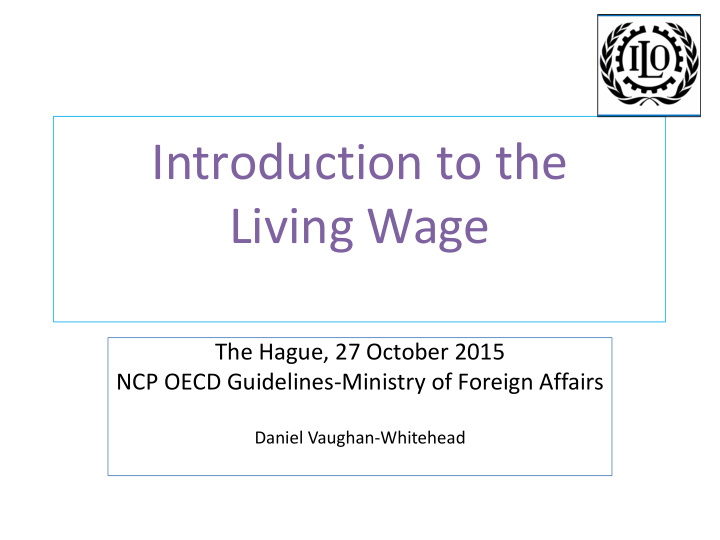



Introduction to the Living Wage The Hague, 27 October 2015 NCP OECD Guidelines-Ministry of Foreign Affairs Daniel Vaughan-Whitehead
Presentation • Why such a growing interest in ‘Living wages ’? • How to define a living wage? • What policy action to take?
What does explain the growing interest in ‘Living wages ’? - The Global context - The Institutional deficit - Wage practices at the end of global supply chains
The global context • Catching up process in wages and living standards • But wage moderation worldwide • Unequal growth redistribution: Wage share decline • Growing wage inequality between top half and bottom half of the distribution • Low pay workers 4
The institutional deficit • On minimum wage first because according to ILO convention 131 on the minimum wage, it should take into account the need to provide decent living standards to individual workers and their families • On collective bargaining since it is aimed at allowing some negotiated wage increases above the wage floor that the minimum wage should represent • On labour inspection mechanisms then since we saw so many cases on non legal compliance on important aspects like the payment of overtime hours and even of the minimum wage • On pay systems finally with often totally dis-balanced pay schemes among suppliers, either totally dependent on piece rates, or not allowing wages to reflect different skills, education backgrounds and individual professional experiences • Also a lack of mechanisms to link wages to productivity at enterprise level, which explains of course declining wage share at global level
Low minimum wage Mean Living Wage-to-Minimum Wage Ratios ( 𝑴𝑿 𝒋𝒖 : 𝑵𝑿 𝒋𝒖 ) by Cluster, 714 obs.
Low collective bargaining
Wage practices at the end of global supply chains • Double even triple records • Problems of legal compliance on overtime payments • often also non compliance of minimum wage payment despite the low minimum wage • Rudimentary pay systems like piece rates • Lack of social dialogue and sometimes even no acceptance of trade unions
A sustainability issue • These general global trends are not sustainable at global and at country level • Enterprise wage developments especially along supply chain are not sustainable either • Need to look at the Living wage debate within the sustainability logic • Sustainability requires institutions, changing mentalities and practices, and responsibilities of different actors
How to define a living wage? • ILO (references in Constitution and Declaration of Philadelphia): minimum wage should serve to guarantee workers at least “a basic minimum standard of living which is compatible with human dignity ”. UN: “everyone who works has the right to just and favourable remuneration ensuring for himself and his family an existence worthy of human dignity ”. OECD: ‘ adequate to satisfy basic needs of the workers and their families ’ • Very similar and general definitions but how to calculate such a living minimum wage? There is no generally accepted definition of how a living wage should be measured. • The ILO commissioned studies on the living wage to define the necessary conditions to be taken into account in the calculation of such a living wage but there is clearly a methodological issue since there is a high degree of “ subjectivity ” and no universal benchmark; moreover difficult to keep up to date such measures along price increases. No universally accepted formula .
Some basic conditions to define the living wage If labour market institutions are too weak, the definition of a living wage may be a useful benchmark for companies that have the capacity to pay (such as MNCs). At the same time, the definition of a living wage should take into account local conditions Its adjustments should be made regularly and involve social partners and local stakeholders But “living wages” should not be seen as substitutes for collective bargaining and minimum wage setting. It should be sustainable and not imposed to suppliers by brands that should modify accordingly their purchasing practices
What policy action to take? • The ILO stands for the strengthening of labour market institutions as the most sustainable, inclusive, and legitimate way to ensure that economic growth translates into wage increases. • Within the context of its cooperation on minimum wage setting, the ILO is actively supporting Member States and constituents in the definition of “living wages” – including to develop indicators and statistics – which needs to be used as one criteria in determining the level of the minimum wage; the other one being economic factors. • The ILO can only regard “living wages” as complement rather than substitute for collective bargaining and minimum wages. • Will further explore these issues in its ILC discussion in 2016
This conference • Excellent initiative: shows governments have a role to play together with all the actors in this room, brands, suppliers, NGOs, International organizations • Governments federators of multi- stakeholders’ interests and initiatives
Recommend
More recommend